
views
X
Expert Source
Craig MortonAquarium Specialist, Aquarium Doctor Inc.
Expert Interview. 21 July 2020.
Acclimating with the Floating Method
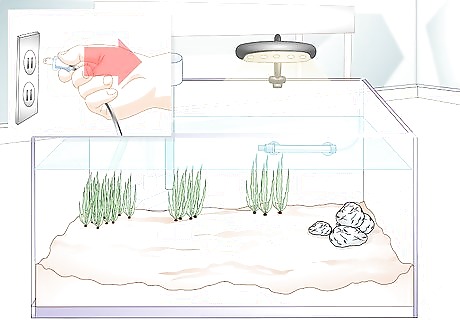
Turn off aquarium light and dim the lights in the room where you're aquarium is set up. Do this before you remove your fish from the carrying container, since fish are sensitive to light and may be traumatized by a sudden change in lighting. Once your fish is used to the tank, you can be less strict about lighting. It's a good idea to initially introduce your fish to a dim environment, as this will reduce the shock of being introduced to a new environment.
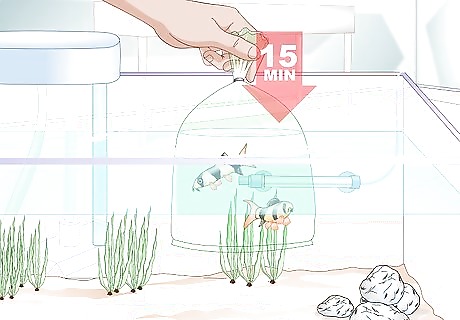
Float the bag in the water for 15-30 minutes. Your fish likely came in a bag from a pet store. If your fish did not come in a bag, you can transfer the fish and water to a small, plastic bag. Tie the end of the bag together and use a rubber band to seal the bag. It's important the bag is sealed tight, as your want your fish to stay in its original water for the initial 15-30 minutes minutes. Simply set the bag on top of the water in the quarantine tank. The fish bag should float on the water's surface. Set a timer for 15 minutes. Keep an eye on the bag during this time to make sure it does not fall over or come undone. For about 15 minutes, allow the bag to float. This way, the water in the bag will gradually become the same temperature as the water in the tank.

Cut open the bag. Cut it just under the metal clip or rubber band keeping the bag closed. Roll down the top edges of the bag about an inch. This will create an air pocket. This pocket will allow the bag to float as you begin adding water from the tank to the bag. If you're acclimating a heavier fish, you may have to place the bag in a floatable device like a small tupperware container.

Add water to the bag every 4 minutes. Get a measuring cup. Add a half cup of the aquarium water to the bag. Allow the bag to float for another 4 minutes. When 4 minutes have passed, add another half cup of aquarium water to the bag. Keep adding water from the aquarium every 4 minutes until the bag is completely full. How long this process will take varies. For a smaller bag, you may only need to add a couple of half cups. For a larger bag, you may need to add water 3 or 4 times before the bag is full.

Discard half the water and float the bag again. Once the bag is full, carefully lift it out of the water. Pour about half the water from the bag down the sink. After discarding the water, place the bag back in the quarantine tank. Allow the bag to start floating again.

Add water from the tank every 4 minutes. Once again, you will add half a cup of water to the bag every 4 minutes. Keep adding water from the tank until the bag is full. Once again, length will vary. For a small bag, you may only need to add a couple half cups. A larger bag may need to be filled 3 or 4 times until it's full.
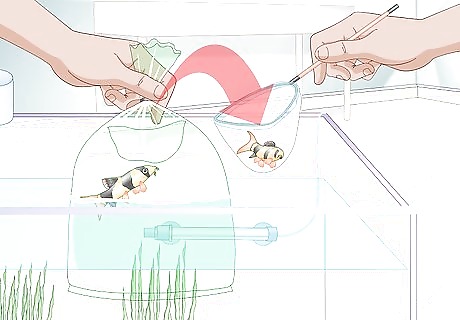
Release the fish into the tank. You will need a small net here. Dip your net into the bag and get your fish in the net. Gently lift the fish out of the bag and place it into the tank. Make sure to be gentle as you net your fish. You do not want your fish to become tangled in the netting. Use a slow, swooping gesture to capture your fish. Be gentle, but quick, when you transfer your fish to the main water. You do not want your fish to be out of water for too long.
Acclimating with the Drip Method
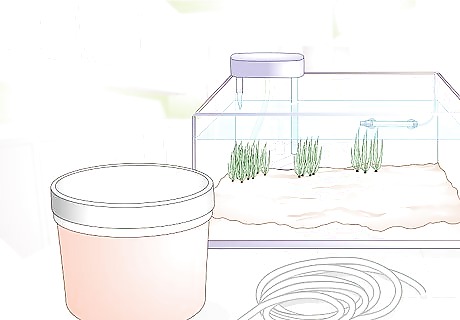
Gather your supplies. For more sensitive fish, such as shrimp and sea stars, you may have to use the drip method. With the drip method, you set up a series of tubes running from the main tank to a bucket of water. You will need the following to use the drip method: You will need 3 or 5 gallon buckets, designed for aquarium use. You will also need airline tubing.
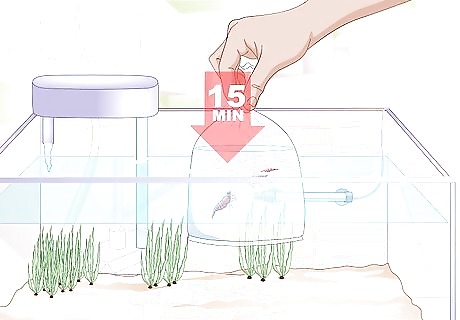
Float the fish initially. Fill the buckets a little under halfway full with clean aquarium water. You will need to start off by floating the fish to acclimate it to the water in the buckets. Let the sealed bag float for 15 minutes. Then, open the bag and roll the sides down to create an air tube that will keep the bag floating. Add half a cup of the water from the bucket to the bag. Wait 15 minutes. Add another half cup. Keep going until the bucket is full.

Transfer water to the bucket. Gently lift up the bag. Pour the contents of the bag, including your fish, into the water. You may have to tilt the bag at a 45 degree angle when pouring. This will keep your fish fully submerged in water as you transfer it to the bucket.
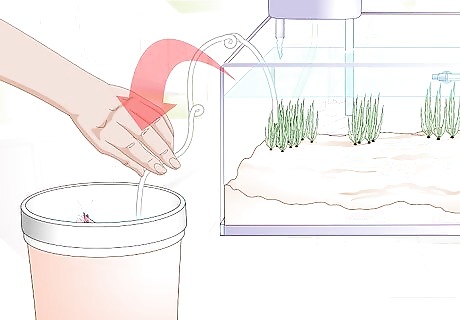
Set up a siphon drip. Place one end of the airline tube in the aquarium. You should also tie several very loose knots in the tubing. This will help regulate the flow of water and air. You want to get a rate of 2 or 4 drips per second. You can get water to start flowing by sucking gently on the other end of the tube. Once water begins dripping, place the other end of the tube on the edge of the bucket.

Discard half the water once the water doubles. It may take awhile for the water in the bucket to double, so be patient. In general, it takes about an hour. As soon as the water doubles, carefully discard half the water. You may have to scoop out the water using a cup or smaller bucket to avoid dumping your fish. When you're done discarding the water, put your tubing back in place. Once again, suck on the end of the tube you're placing in the bucket to get a drip going. Wait for the water in the bucket to double again.
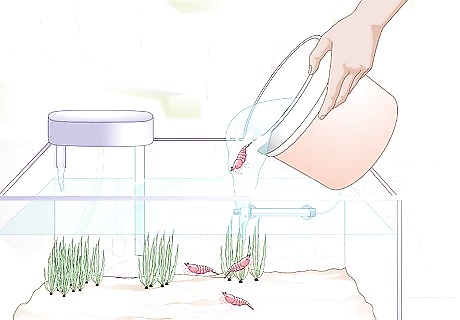
Transfer your fish to the main tank. Use a bag to gently scoop out your fish. Gently pour the contents of the bag into the main aquarium. Some species of fish should never be exposed to air. Sponges, clams, and gorgonias cannot handle air. Be extra careful when transferring these types of fish.
Utilizing A Quarantine Tank
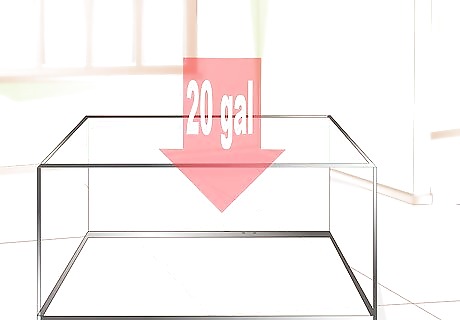
Get your tank. A quarantine tank is important as it keeps a fish away from the rest of your aquarium. It is highly reccomended you use a quarantine tank before acclimating your fish to your main aquarium. If a fish you just bought is sick, you do not want the infection to spread to the rest of your tank. After buying a new fish, purchase another tank to use as a quarantine tank. You do not need to get a fancy tank. A simple 10 to 20 gallon tank should be big enough for a quarantine tank. You can purchase an aquarium at a pet store. You can also order one online.

Install a filtration system. As with a regular aquarium, your quarantine tank should have some kind of filtration system. This will keep your fish safe and healthy during the quarantine period. If possible, go for a tank with a built in filtration system. If your tank does not have a built in system, purchase a filtration system at a local pet shop. Install it in the tank when you get home, following manufacturer's instructions.
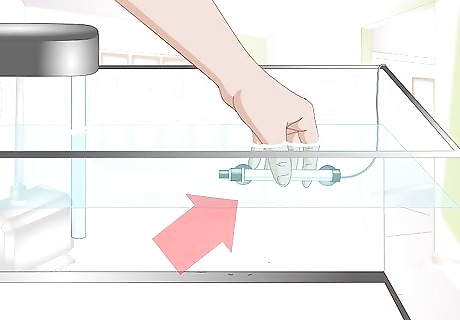
Add a heater. This will keep the water at a safe temperature for your fish. You should also get a thermometer to record the temperature. You want to make sure the temperature is safe before transferring your fish to the quarantine tank. An aquarium may have a built in heating system. If yours does not, you can buy one at a pet store. The proper temperature depends on the type of fish you have. Ask at the pet store what a safe temperature for your fish would be.
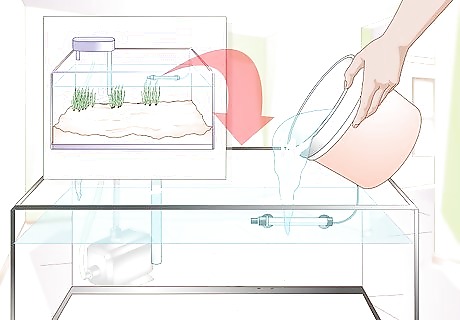
Fill the aquarium with water from your main tank. The quarantine tank should be similar to your regular tank. Once your fish is ready to be transferred to the regular tank, you want the transition to be as smooth as possible. Take water from your main tank, using a bucket or cup, and fill up your quarantine tank. Once the quarantine tank is full, you can turn on the heater and filtration system.

Monitor your fish for 2 to 3 weeks in the quarantine tank. Watch your fish closely during this time. Before introducing a fish to a tank of other aquatic life, you want to make sure it does not have any diseases. Diseases can spread fast in a fish tank. Common infections include things like fin rot, vibriosis, and mouth rot. Usually, you would treat infections with antibiotics. Antibiotics may be administered to a fish's tank, or you may give your fish food with antibiotics. Symptoms of infections changes in color, frayed or rotting fins, a lack of appetite, gray marks on the scale and fins, and open sores on a fish. If your fish has an infection, make sure it is treated and symptoms are gone before transferring your fish to the main aquarium.
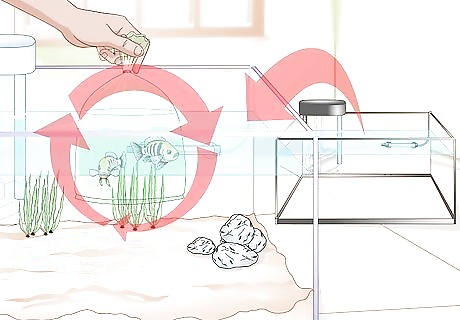
Repeat the floating process to transfer the fish to the regular tank. If two to three weeks pass without incident, you can transfer your fish to the regular tank. You would repeat the same floating process you used to acclimate your fish to the quarantine tank. You will have to net your fish and place it in a bag filled with water from the quarantine tank. Make sure to seal the bag with a metal clip or rubber band. Float the bag in the regular tank for 15 minutes, cut the bag open, and roll down the edges an inch. Transfer half a cup of water to the bag every 4 minutes until it's full. Discard half the water in the bag, and float it in the tank again. Once again, transfer water every 4 minutes until the bag is full. Net the fish and transfer it into the main tank.




















Comments
0 comment